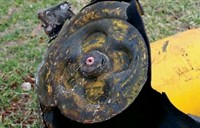Advertisement
Grab your lab coat. Let's get started
Welcome!
Welcome!
Create an account below to get 6 C&EN articles per month, receive newsletters and more - all free.
It seems this is your first time logging in online. Please enter the following information to continue.
As an ACS member you automatically get access to this site. All we need is few more details to create your reading experience.
Not you? Sign in with a different account.
Not you? Sign in with a different account.
ERROR 1
ERROR 1
ERROR 2
ERROR 2
ERROR 2
ERROR 2
ERROR 2
Password and Confirm password must match.
If you have an ACS member number, please enter it here so we can link this account to your membership. (optional)
ERROR 2
ACS values your privacy. By submitting your information, you are gaining access to C&EN and subscribing to our weekly newsletter. We use the information you provide to make your reading experience better, and we will never sell your data to third party members.
Chemical Weapons
Syria is responsible for three chemical weapons attacks in 2017, investigation says
Lab tests form part of the evidence for investigation and identification team’s report
by Laura Howes
April 17, 2020

The Organisation for the Prohibition of Chemical Weapons (OPCW) released the first report by the organization’s newly formed Investigation and Identification Team (IIT) on April 8. The report focuses on chlorine and sarin attacks in Ltamenah, Syria, in March 2017 and concludes that Syrian government forces were responsible for all three attacks.
This report is the first to be published from the IIT, which was formed after the United Nations-OPCW Joint Investigative Mechanism (JIM) was dissolved in 2017 after a UN Security Council dispute. The IIT began its work in June 2019. It is mandated specifically to identify the perpetrators of the use of chemical weapons in the Syrian Arab Republic.
As part of the investigations into the three incidents in March 2017, the IIT requested that six OPCW designated laboratories analyze samples. The IIT also interviewed witnesses and consulted with technical institutions and experts, according to a statement by IIT coordinator Santiago Oñate-Laborde.
The IIT determined that an attack on March 25, 2017, involved chlorine dropped from an Syrian Arab Air Force helicopter. The IIT notes that “there is no single chemical that would unequivocally and directly indicate the use of chlorine gas and its origin,” but mass spectrometry and ion chromatography confirmed chloride-containing species in the mud and soil near where the gas was likely released.
Chemistry played a greater role in confirming the use of sarin in attacks on March 24 and 30, 2017, and attributing responsibility to Syria. The part of the IIT report detailing the sarin chemical analysis is redacted from the publicly-available document and details about the work are classed as highly protected, the OPCW’s version of top secret.
In other parts of the report, the IIT says that samples from the impact craters and surrounding environments “showed the presence of chemicals relevant to the ‘signature’ of sarin consistent with the precursors and the process used by the Syrian Arab Republic.” In particular, the report says that the chemical profile is similar to that expected if the sarin was produced through a reaction of methylphosphonyl difluoride with isopropyl alcohol and hexamine.
Chemical weapons expert and former OPCW laboratory head Marc-Michael Blum notes that three chemical markers—phosphorus hexafluoride, isopropyl phosphate, and isopropyl phosphorofluoridate—were found in sarin used in an April 4, 2017 attack in Khan Shaykhun, Syria, as documented in the disbanded JIM’s final report. The JIM also reported the same markers in methylphosphonyl difluoride, a sarin precursor, that was surrendered by Syria as part of its chemical weapons decommissioning process. Those impurities come from using hydrofluoric acid as a fluoridating agent and are thought to be a fingerprint for the Syrian Arab Republic’s stockpile, the JIM report says.
Although the IIT doesn’t publicly name these markers, its report does say that the sarin used at Ltamenah has similarities to the sarin used at Khan Shaykhun. “If this is the case, it would represent strong chemical evidence,” Blum says, although he is careful to point out that the chemical analysis is only one piece of evidence used to determine responsibility for the attack.
“IIT used several methods to determine that the sarin used in Ltamenah had been produced by the Syrian government,” agrees Gregory D. Koblentz, director of the Biodefense Graduate Program at George Mason University and a member of the Scientists Working Group on Chemical and Biological Security. “The combination of these different analyses and methodologies provide damning evidence that Syria has used sarin to attack civilians on multiple occasions.”
However, while the IIT can identify individuals and entities responsible for chemical attacks in Syria, it cannot issue sanctions.
“Chemical weapons use cannot and will not be tolerated,” US ambassador to the OPCW Kenneth D. Ward says in a statement. “The United States will work with responsible States Parties to ensure that Syria is held accountable and that effective actions are taken by the Executive Council and the Conference of the States Parties to redress this situation.”
CORRECTION
This story was updated on April 23, 2020, to correct a date in the caption. The sarin attacks on Ltamenah were on March 24 and 30, 2017, not March 25 and 30, 2017. An attack on March 25, 2017, involved chlorine.




Join the conversation
Contact the reporter
Submit a Letter to the Editor for publication
Engage with us on Twitter